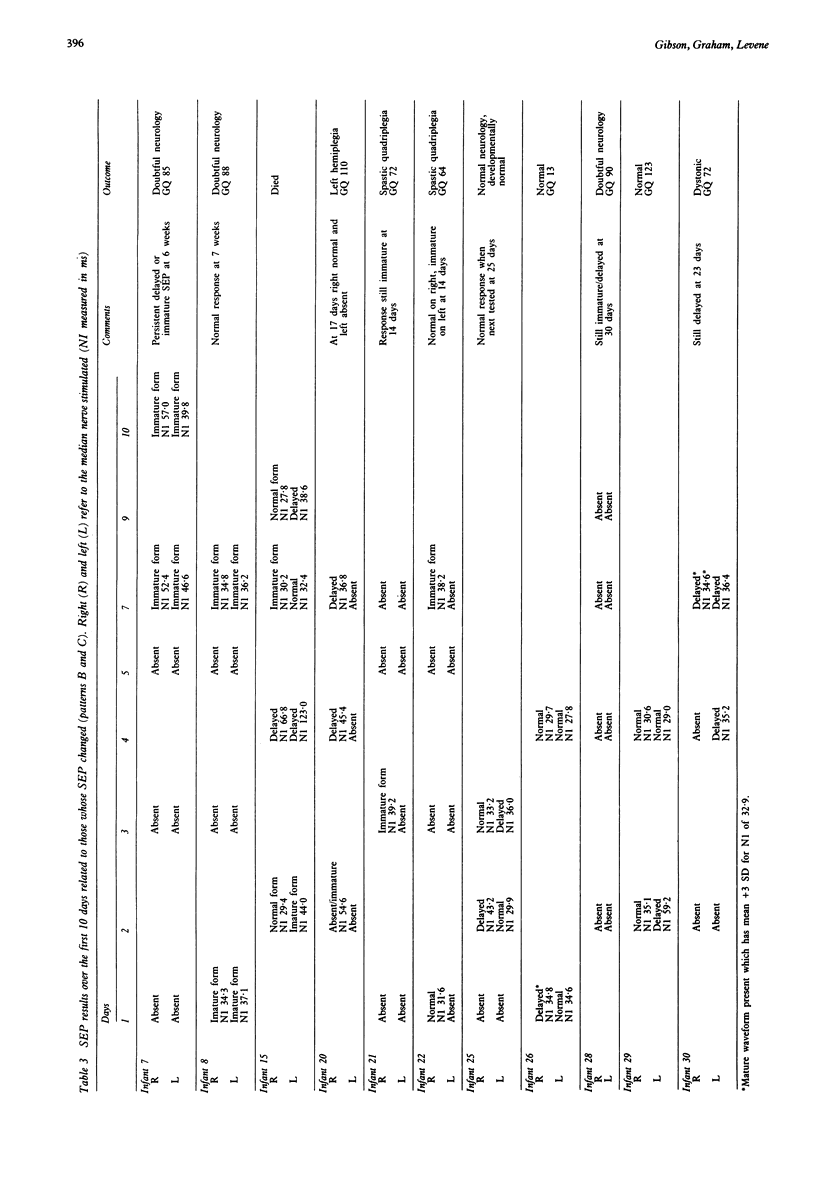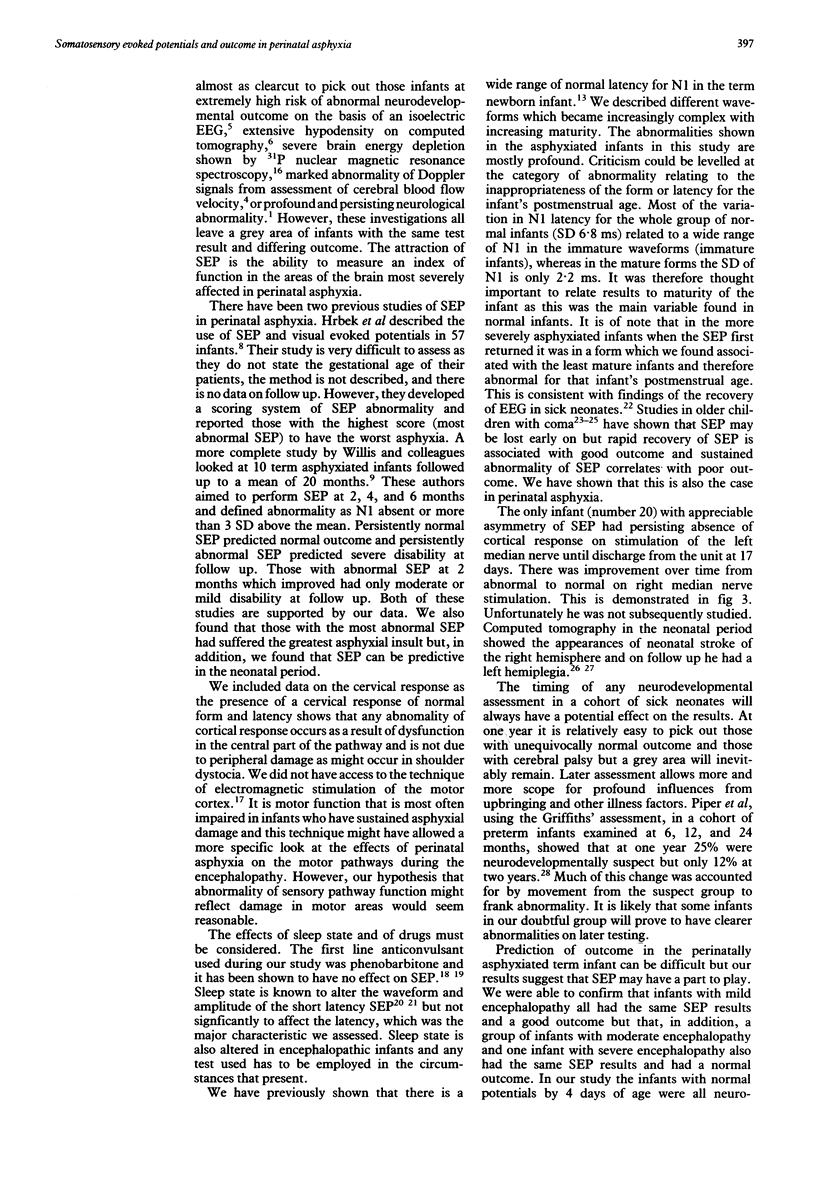Abstract
Somatosensory evoked potentials (SEP) can be measured in the term newborn infant and given an index of function in the areas of the brain most likely to be damaged in perinatal asphyxia. We studied the median nerve SEP in 30 asphyxiated term infants over the course of their encephalopathy and until discharge from the neonatal unit. Three types of response were noted: normal waveform, abnormal waveform, or absence of cortical response. Follow up of the survivors was undertaken at a mean age of 12 months by means of a Griffiths' assessment and neurological examination. Nine infants died of their asphyxial illness and one of spinal muscular atrophy. Of the 20 survivors, three have cerebral palsy, four have minor abnormalities, and 13 are neurodevelopmentally normal. There was a close correlation between outcome and SEP. All 13 infants with normal outcome had normal SEP by 4 days of age, whereas those with abnormal or absent responses beyond 4 days had abnormalities at follow up.
Full text
PDF





Selected References
These references are in PubMed. This may not be the complete list of references from this article.
- Adsett D. B., Fitz C. R., Hill A. Hypoxic-ischaemic cerebral injury in the term newborn: correlation of CT findings with neurological outcome. Dev Med Child Neurol. 1985 Apr;27(2):155–160. doi: 10.1111/j.1469-8749.1985.tb03764.x. [DOI] [PubMed] [Google Scholar]
- Bender B. S., Bennett R., Laughon B. E., Greenough W. B., 3rd, Gaydos C., Sears S. D., Forman M. S., Bartlett J. G. Is Clostridium difficile endemic in chronic-care facilities? Lancet. 1986 Jul 5;2(8497):11–13. doi: 10.1016/s0140-6736(86)92559-6. [DOI] [PubMed] [Google Scholar]
- Borah N. C., Matheshwari M. C. Effect of antiepileptic drugs on short-latency somatosensory evoked potentials. Acta Neurol Scand. 1985 Apr;71(4):331–333. doi: 10.1111/j.1600-0404.1985.tb03209.x. [DOI] [PubMed] [Google Scholar]
- Brown J. K., Purvis R. J., Forfar J. O., Cockburn F. Neurological aspects of perinatal asphyxia. Dev Med Child Neurol. 1974 Oct;16(5):567–580. doi: 10.1111/j.1469-8749.1974.tb04176.x. [DOI] [PubMed] [Google Scholar]
- De Meirleir L. J., Taylor M. J. Prognostic utility of SEPs in comatose children. Pediatr Neurol. 1987 Mar-Apr;3(2):78–82. doi: 10.1016/0887-8994(87)90031-2. [DOI] [PubMed] [Google Scholar]
- Finer N. N., Robertson C. M., Richards R. T., Pinnell L. E., Peters K. L. Hypoxic-ischemic encephalopathy in term neonates: perinatal factors and outcome. J Pediatr. 1981 Jan;98(1):112–117. doi: 10.1016/s0022-3476(81)80555-0. [DOI] [PubMed] [Google Scholar]
- Fitzhardinge P. M., Flodmark O., Fitz C. R., Ashby S. The prognostic value of computed tomography as an adjunct to assessment of the term infant with postasphyxial encephalopathy. J Pediatr. 1981 Nov;99(5):777–781. doi: 10.1016/s0022-3476(81)80410-6. [DOI] [PubMed] [Google Scholar]
- Ganes T., Lundar T. The effect of thiopentone on somatosensory evoked responses and EEGs in comatose patients. J Neurol Neurosurg Psychiatry. 1983 Jun;46(6):509–514. doi: 10.1136/jnnp.46.6.509. [DOI] [PMC free article] [PubMed] [Google Scholar]
- Goff W. R., Shaywitz B. A., Goff G. D., Reisenauer M. A., Jasiorkowski J. G., Venes J. L., Rothstein P. T. Somatic evoked potential evaluation of cerebral status in Reye syndrome. Electroencephalogr Clin Neurophysiol. 1983 Apr;55(4):388–398. doi: 10.1016/0013-4694(83)90126-8. [DOI] [PubMed] [Google Scholar]
- Holmes G., Rowe J., Hafford J., Schmidt R., Testa M., Zimmerman A. Prognostic value of the electroencephalogram in neonatal asphyxia. Electroencephalogr Clin Neurophysiol. 1982 Jan;53(1):60–72. doi: 10.1016/0013-4694(82)90106-7. [DOI] [PubMed] [Google Scholar]
- Hope P. L., Costello A. M., Cady E. B., Delpy D. T., Tofts P. S., Chu A., Hamilton P. A., Reynolds E. O., Wilkie D. R. Cerebral energy metabolism studied with phosphorus NMR spectroscopy in normal and birth-asphyxiated infants. Lancet. 1984 Aug 18;2(8399):366–370. doi: 10.1016/s0140-6736(84)90539-7. [DOI] [PubMed] [Google Scholar]
- Hrbek A., Karlberg P., Kjellmer I., Olsson T., Riha M. Clinical application of evoked electroencephalographic responses in newborn infants. I: Perinatal asphyxia. Dev Med Child Neurol. 1977 Feb;19(1):34–44. doi: 10.1111/j.1469-8749.1977.tb08017.x. [DOI] [PubMed] [Google Scholar]
- Koh T. H., Aynsley-Green A., Tarbit M., Eyre J. A. Neural dysfunction during hypoglycaemia. Arch Dis Child. 1988 Nov;63(11):1353–1358. doi: 10.1136/adc.63.11.1353. [DOI] [PMC free article] [PubMed] [Google Scholar]
- Koh T. H., Eyre J. A. Maturation of corticospinal tracts assessed by electromagnetic stimulation of the motor cortex. Arch Dis Child. 1988 Nov;63(11):1347–1352. doi: 10.1136/adc.63.11.1347. [DOI] [PMC free article] [PubMed] [Google Scholar]
- Levene M. L., Kornberg J., Williams T. H. The incidence and severity of post-asphyxial encephalopathy in full-term infants. Early Hum Dev. 1985 May;11(1):21–26. doi: 10.1016/0378-3782(85)90115-x. [DOI] [PubMed] [Google Scholar]
- Lütschg J., Pfenninger J., Ludin H. P., Vassella F. Brain-stem auditory evoked potentials and early somatosensory evoked potentials in neurointensively treated comatose children. Am J Dis Child. 1983 May;137(5):421–426. doi: 10.1001/archpedi.1983.02140310003001. [DOI] [PubMed] [Google Scholar]
- Mannino F. L., Trauner D. A. Stroke in neonates. J Pediatr. 1983 Apr;102(4):605–610. doi: 10.1016/s0022-3476(83)80200-5. [DOI] [PubMed] [Google Scholar]
- Ment L. R., Duncan C. C., Ehrenkranz R. A. Perinatal cerebral infarction. Ann Neurol. 1984 Nov;16(5):559–568. doi: 10.1002/ana.410160506. [DOI] [PubMed] [Google Scholar]
- Piper M. C., Mazer B., Silver K. M., Ramsay M. Resolution of neurological symptoms in high-risk infants during the first two years of life. Dev Med Child Neurol. 1988 Feb;30(1):26–35. doi: 10.1111/j.1469-8749.1988.tb04723.x. [DOI] [PubMed] [Google Scholar]
- Ruth V. J., Raivio K. O. Perinatal brain damage: predictive value of metabolic acidosis and the Apgar score. BMJ. 1988 Jul 2;297(6640):24–27. doi: 10.1136/bmj.297.6640.24. [DOI] [PMC free article] [PubMed] [Google Scholar]
- Sarnat H. B., Sarnat M. S. Neonatal encephalopathy following fetal distress. A clinical and electroencephalographic study. Arch Neurol. 1976 Oct;33(10):696–705. doi: 10.1001/archneur.1976.00500100030012. [DOI] [PubMed] [Google Scholar]
- Willis J., Duncan C., Bell R. Short-latency somatosensory evoked potentials in perinatal asphyxia. Pediatr Neurol. 1987 Jul-Aug;3(4):203–207. doi: 10.1016/0887-8994(87)90017-8. [DOI] [PubMed] [Google Scholar]


